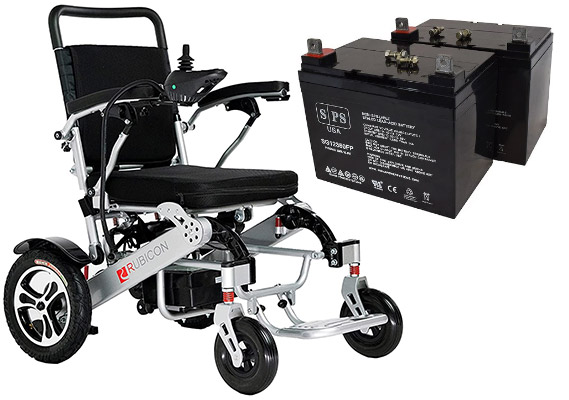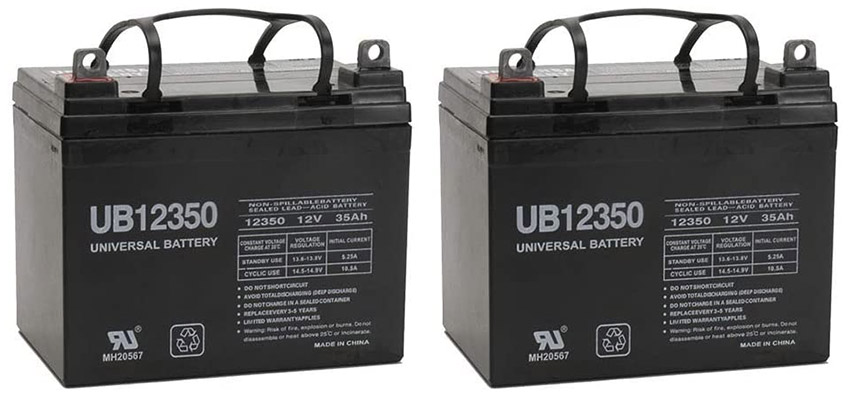Is your powerchair leaving you underwhelmed with its disappointing performance? It’s a common enough problem that has a somewhat surprising root cause. Battery Mismanagement!
If you don’t take care of your electric wheelchair battery and don’t use your batteries properly, you’re almost certain to be disappointed by your chair’s performance.
In this article, we’ll list out a number of handy “battery rules” that will help you get the most out of your chair or scooter, whatever brand, make or model you own. If that sounds good to you, let’s jump right in and take a closer look.
Power Wheelchair Battery Rules to Live By

Acknowledge Real World Ranges & the Limits of Your Chair
Your battery, however big it is, can only store and deliver so much power. Whatever that number is, it’s going to be one of the major factors that determine the range you can realistically expect to get out of your charge.
While there are lots of factors to consider, the major parameters that define the range you can expect are:
- The size and output of your battery
- Your weight, plus the weight of your chair
- The type of terrain you’re using your chair in
- And how fast you’re running
The combination and interplay of those things will ultimately determine how far you can get on a charge.
Of the bullet points listed above, we only know the details on battery size. The rest is going to be unique to your specific situation. With that in mind, here’s a handy chart that will give you some baseline numbers:
| Battery Size | Real-World Range* |
|---|---|
| U1 30Ah – 40Ah | 10- to 12-miles |
| NF22 50Ah – 60Ah | 11- to 14-miles |
| Group-34 60Ah | 12- to 15-miles |
| Group-24 70Ah to 80 Ah | 14- to 16-miles |
| Group-27 95Ah to 105 Ah | 18- to 22-miles |
So if we assume typical urban terrain (smooth sidewalks) and a fully charged chair operating at its median speed, and a user of average weight, the range numbers above give you a good starting point.
To give you an idea of how much performance can fall off, though, let’s say that your chair uses group 24 batteries, indicating a 14-16 mile range under the conditions described above.
If you run that same chair in your home at very low speeds and on a plush carpet, you’ll find that the power draw is 2-3 times greater, meaning that the chair’s range might be as low as 5 miles. That’s a huge difference, and it really underscores how big an impact all of the factors we initially talked about can have.
It also underscores the importance of mindfulness. If you’ve spent half the day puttering around the house in your chair and you’ve burned through half your battery power, you may need a recharge before heading to a nearby store (depending on how far it is to get there and back). If you’re not mindful, you could easily wind up stranded.
Recharge Your Batteries Every Day!
It’s a good idea to get in the habit of recharging your chair every day. Just make it part of your “getting ready for bed” routine.
If you do, your chair will recharge while you’re fast asleep and will be ready for you by the time you get up and are ready to start your day. If you’re worried that you’ll hurt your batteries by leaving them on the charger, you won’t, assuming you’re using the charger that came with your powerchair.
Most chargers offered with powerchairs today have a built-in auto-shutoff feature that will prevent your battery from overcharging, so there’s no risk to you or your expensive equipment.
Disconnect Your Batteries If You Only Use Your Power Chair Occasionally
If you have a severe mobility issue, then you’re almost certainly going to be using your chair every single day. If you only use it occasionally, though, it would be better for the longevity of your batteries if you only connect them when you need them.
The rule of thumb here is two weeks. If you know it’s going to be a couple of weeks before you use your chair again, your best bet is to disconnect. Your batteries will thank you!
Mind Your Depletion Levels
Powerchair batteries are Deep-Cycle batteries. You can drain and recharge them repeatedly. How many recharges you get, though, is at least partially determined by how often you recharge.
For example, if you use your chair today and drain the battery to 50%, then recharge it that night, your battery will last far longer than if you use your chair for several days in a row, depleting your battery to 20% and then recharge. Your battery will literally last about twice as long in the first case compared to the second.
Being mindful of your discharge levels is also important on a practical level because your discharge level is really an indication of how far your chair will carry you before you need to plug it in. Knowing that is key if you don’t want to wind up getting stranded inconveniently far from home on a regular basis.

Plan Ahead Where Replacements Are Concerned
Finally, don’t wait to buy replacement batteries until you need them. If you do, you’re almost certain to either get stuck at home or stranded out somewhere.
How long your batteries last is highly dependent on how you use them and how good your charging habits are.
With poor habits, you can expect to get about a year out of your batteries. With good habits, you may get as many as three.
Pair that knowledge with the fact that deep-cycle batteries have about a six months shelf life, and you can start to wrap your brain around when you need to start thinking about replacements.
Final Thoughts on Electric Wheelchair Battery Rules
How many of the tips above are you already putting into practice? The fewer of them you’re currently utilizing, the less happy you probably are with the performance of your powerchair.
The good news is that it’s a fairly easy thing to fix. If you follow the “electric wheelchair battery rules to live by” we’ve laid out above, you’ll be much happier with your chair’s overall performance.
Resources & References:
- Better Batteries, Better Wheeling, Newmobility.
- Electric Wheelchairs & Mobility Scooters, Ryanair.
- Wheelchair Batteries: Driving Cycles and Testing, Rehab Research.
- Wheelchairs and Mobility Devices With Lithium Ion Batteries, Normal Design, Battery Installed, FAA.